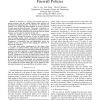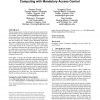832 search results - page 122 / 167 » Effect of Malicious Synchronization |
INFOCOM
2008
IEEE
14 years 4 months ago
2008
IEEE
—A firewall is a security guard placed between a private network and the outside Internet that monitors all incoming and outgoing packets. The function of a firewall is to exam...
INFOCOM
2008
IEEE
14 years 4 months ago
2008
IEEE
—Trusted Collaborative Computing (TCC) is a new research and application paradigm. Two important challenges in such a context are represented by secure information transmission a...
IPCCC
2007
IEEE
14 years 4 months ago
2007
IEEE
Rapidly-spreading malicious software is an important threat on today’s computer networks. Most solutions that have been proposed to counter this threat are based on our ability ...
CCS
2007
ACM
14 years 4 months ago
2007
ACM
The increasing number of software-based attacks has attracted substantial efforts to prevent applications from malicious interference. For example, Trusted Computing (TC) technolo...
ACSAC
2006
IEEE
14 years 4 months ago
2006
IEEE
Address space randomization is an emerging and promising method for stopping a broad range of memory corruption attacks. By randomly shifting critical memory regions at process in...


